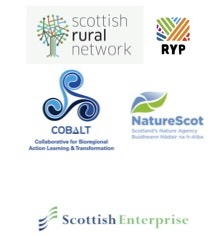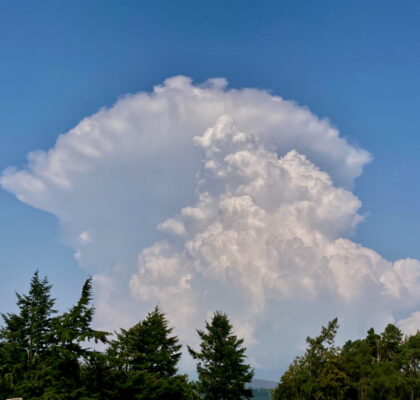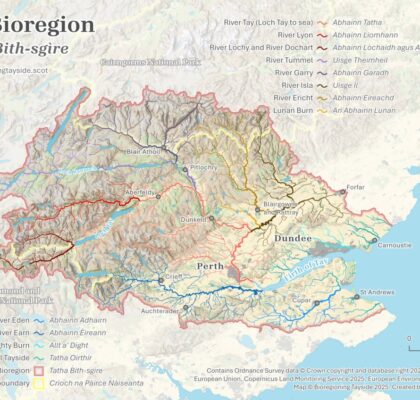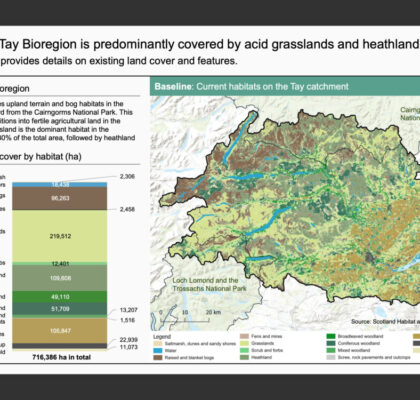Our third Learning Journey event focused on tourism, which in common with all of Scotland and many other parts of the world plays a key role in the economy of Tayside.
Tourism is evolving fast. COVID-19, the climate and biodiversity crises and new major geopolitical instability is changing how people travel, where to and why; even whether they can travel at all. In this state of global ‘permacrisis’, new questions are being asked about tourism and old assumptions are being challenged – Is travel a right or a privilege? Should growth in tourism continue to be encouraged and who gets to decide? How can destinations continue to develop in the light of this new operating environment and who pays?
In this on-line event, we invited three contributors to give their perspective on whether tourism can help Tayside #RaceToZero.
Flourishing Destinations
First up was Alison Elliott from Angus Tourism Co-operative’s ‘Flourishing Destinations‘ Project. This initiative began life as a Transnational Co-operation Project supported by the European LEADER programme and has involved building the capacity of three visitor destinations in Angus, Scotland, Meetjesland in Belgium and Bazinul Dornelor in Romania. The principle objective is for each destination to grow their tourism activities, but in a way that is mindful of both people and planet.
Each area saw themselves as tourism ‘developers’, with growth potential but without the one big attraction that acts as a ‘honey pot’ to attract large numbers of tourists. Meeting on-line and in person (although some of the latter was delayed due to the COVID-19 Pandemic) they worked through a model approach to community-led sustainable tourism, testing the model against real examples of tourism development in action. The project also served as an opportunity to develop the local tourism community and its relationship to the local community generally.
Learning visits to each area formed a key part of the project, enabling around 30 individuals from each country to visit the other regions and learn first hand from like- minded individuals, visit local enterprises and activities and share lessons learned within their own region. Each trip focused around the project’s three main themes: welcoming visitors, promoting local food and drink and developing traditional rural skills.
The main achievements of the project has been to support the local tourism communities and to focus them on joint cooperative, sustainable development of their area and there have been a number of outcomes;
- Increased numbers of local actors are now more engaged in wider community and rural development considerations and have used the project to profile their work at regional and national level.
- Local areas’ tourism communities are all strengthened by encouraging people to take a more integrated and broader approach.
- The project has highlighted the need for local shared interests to find a way of interacting and of co-producing the tourism offer. A more connected tourism sector is ultimately of more value to both the visitor and the local.
- The personal development of the people involved, acquired from being engaged in funded and structured networking activities.
- The role of the Flourishing Destinations approach, while essential at the project’s early stages, latterly provided a useful benchmark against which practice and theory can be weighed.
- The impact of the project is being noted much more widely across each of the countries, particularly in Scotland and Belgium at the moment. With Scotland potentially using Angus as a government pilot and Meetjesland taking their wider tourism region on a community-led tourism journey. In Scotland, Angus was the first local authority region to use ‘pride of place and community’ as a main theme in their tourism strategies and frameworks. This is now being mirrored across the country and nationally in tourism policy. Meetjesland is now doing the same in Belgium.
You can watch a short video about the project below.
Travel For All Our Tomorrows
Our second contributor was Clare Cooper, Co-founder and Co-Director of the Cateran Ecomuseum as well as Co-initiator of Bioregioning Tayside. The Cateran Ecomuseum has been pioneering a Regenerative Tourism approach since 2019, when, shortly after its launch, its Director Group decided to focus all of the Ecomuseum’s efforts on mobilising heritage for climate action through its innovative ‘Museum of Rapid Transition’ programme.
You can watch Clare’s short presentation below.
Community-led Tourism, Brechin
Our third contributor was Norma Lyall, also from Angus Tourism Co-operative and founder of Flourish9 and The Book Larder. Norma described Brechin’s ‘Proof of Concept’ Project which had been one of two initiatives (the other being in Girvan in South Ayrshire) which aimed to demonstrate the value and impacts of the community-led tourism approach.
The project was delivered by SENScot in partnership with Creetown Initiative Ltd – funded by the Tourism & Events Division at Scottish Government and aligned to the ambitions set out in the Scotland Outlook 2030 Strategy published by the Scottish Tourism Alliance.
Both Brechin and Girvan were charged with:
- Working with the local community to develop a local steering group with representatives from public, private and third sectors as well as local community.
- Supporting the group in identifying and adopting the most appropriate business model for local development and delivery
- Supporting the group in creating an action plan bespoke to the area and informed by the community- and identify leads within the community – setting out a clear vision and objectives, mapping and analysis of existing tourist provision and identify opportunities for development. Connecting with current Place Plans and regional tourism plans to ensure alignment and no duplication.
- Providing access to financial resource and unlock external funding opportunities to expand capacity and enable delivery of the first phases of the action plan.
- Working with both communities to identify future funding; investment options and a business plan to ensure long term sustainability.
Community-led tourism is a collaborative approach that puts local people at the centre of the decision- making process to develop a tourism offering which benefits the whole community. Unlike the traditional top-down approach to tourism planning and development, the community-led approach relies on grassroots involvement and community leadership. It looks to build a strategy which allows small, local organisations, communities, and businesses to capture the footfall of visitors who are attracted to larger, popular local assets.
Norma highlighted that recent market changes, driven by COVID-19 and the climate crisis have created opportunities for the tourism industry to redefine its customer base and, as conversations about environmental and social sustainability become ever more prevalent, to look beyond its traditional purpose of creating profit and further recognise the importance of community involvement.
What both destinations found was that the motivation for a community to take control of their tourism offer can develop through a variety of channels such as: a pride and attachment to place; existing social capital; the need to tackle a local power imbalance and local issues; and the chance to explore new opportunities. When a community takes a lead in developing its tourism offer, the focus shifts from solely economic value to social and environmental value. Encouraging local communities to take ownership of tourism in their area can help preserve historic and cultural heritage, improve management of land and assets for community use, encourage the development of new business opportunities, and improve the quality of services and sustainability of the area; socially, economically and environmentally. By working with communities, a valuable resource can be unlocked to create a richer and higher quality experience for visitors.
What communities need to realise this community-led approach was access to resources, both humans and financial, access to relevant knowledge, broader connections and very importantly, to be valued.
Whilst the Brechin initiative was a time-limited project, it was clear that the work was having a significant impact in engaging the community, developing broader connections. and gaining local, regional and national recognition. However, these early wins could only be grown with more consistent investment.

Workshopping the initiative, photo Angus Tourism Co-operative
What all three projects highlighted was the enormous potential that community-led, regenerative tourism has to drive the changes tourism needs in Tayside and everywhere else in the world. To achieve what tourism thought-leader Anna Pollock proposes – ‘Tourism needs an upgrade. Not different software but a whole new operating system.’
But for this to happen in our Bioregion, we need:
- Funding and resource in people, pilots, advocacy and capacity building with the people and projects driving the re-set represented and listened to on relevant tourism body boards and forums, particularly at national level
- Advice and support, probably through a dedicated website that collates, showcases and promotes best practice and signposts to relevant insight, advice, and support (such as SCOTO)
- And most importantly a shift in world view – one which redefines success in tourism and measures progress using a different yardstick.
If everyone involved in tourism in Tayside can ‘rise to the occasion’ in these ways, then this key aspect of how we live and work can be re-directed to help us #RaceToZero.
Resources
Regenerative Tourism: The Essential Ingredients
New Zealand’s Tourism Industry Transformation Plan
Regenerative Tourism: A Conceptual Framework Leveraging Theory & Practice

The 2022 Bioregioning Tayside Learning Journey ‘Change The Frame: Change The Story‘ was supported by the Scottish Rural Network, Scottish Enterprise, the Rural Youth Project, NatureScot and the Collaboration for Bioregional Action Learning & Transformation.


